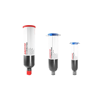Hysol MG52F-99B NXP | Black Epoxy Mold Compound
- MSL 1 260°C
- Ideal for Cu, & Pd plated leadframes
- 28, 48 and 56 pin TSSOP
Product Description
Hysol MG52F-99B NXP is a high productivity molding compound, designed for high volume encapsulation of surface mount devices. MG52F-99B NXP is applicable for devices having chip dimensions up to 1 centimeter (400 mils) square. Various versions are available including MG52F. MG52-99B NXP which is designed to provide much improved moisture performance after preconditioning. It can be applied using both conventional and automold equipment.
MG52F-99B NXP was designed for and passed qualification testing on 28, 48 and 56 pin TSSOP packages and has been used in production for more than 20 years. These packages have a copper leadframe with palladium plating. This material is designed to achieve JEDEC Level 1 requirements at 260°C reflow temperature on copper based, palladium-plated leadframes. Hysol MG52F-99B NXP meets UL 94 V-0 Flammability at 1/8 inch (3.18mm) thickness.
MG52F-99B NXP has high adhesion to a wide range of substrates including Nickel and Palladium, Low stress, fast cure and a large operating window, ideal for low wire sweep molding.
Technical Specifications
| General Properties | |||||||||
| Color Color The color | Black | ||||||||
| Filler Content | 78.8 % | ||||||||
| Specific Gravity Specific Gravity Specific gravity (SG) is the ratio of the density of a substance to the density of a reference substance; equivalently, it is the ratio of the mass of a substance to the mass of a reference substance for the same given volume. For liquids, the reference substance is almost always water (1), while for gases, it is air (1.18) at room temperature. Specific gravity is unitless. | 1.88 | ||||||||
| |||||||||
| Physical Properties | |||||||||
| Spiral Flow @ 175°C | 78 cm | ||||||||
| Chemical Properties | |||||||||
| |||||||||
| Moisture absorption | 0.57 % | ||||||||
| Electrical Properties | |||||||||
| |||||||||
| Volume Resistivity Volume Resistivity Volume resistivity, also called volume resistance, bulk resistance or bulk resistivity is a thickness dependent measurement of the resistivity of a material perpendicular to the plane of the surface. | 1.0x1017 Ohms⋅cm | ||||||||
| Mechanical Properties | |||||||||
| |||||||||
| |||||||||
| Molded Shrinkage | 0.28 % | ||||||||
| |||||||||
| Thermal Properties | |||||||||
| |||||||||
| |||||||||
| Glass Transition Temperature (Tg) Glass Transition Temperature (Tg) The glass transition temperature for organic adhesives is a temperature region where the polymers change from glassy and brittle to soft and rubbery. Increasing the temperature further continues the softening process as the viscosity drops too. Temperatures between the glass transition temperature and below the decomposition point of the adhesive are the best region for bonding. The glass-transition temperature Tg of a material characterizes the range of temperatures over which this glass transition occurs. | 155 °C | ||||||||
| Thermal Conductivity Thermal Conductivity Thermal conductivity describes the ability of a material to conduct heat. It is required by power packages in order to dissipate heat and maintain stable electrical performance. Thermal conductivity units are [W/(m K)] in the SI system and [Btu/(hr ft °F)] in the Imperial system. | 0.95 W/m.K | ||||||||
| UL 94 Rating UL 94 Rating Flammability rating classification. It determines how fast a material burns or extinguishes once it is ignited. HB: slow burning on a horizontal specimen; burning rate less than 76 mm/min for thickness less than 3 mm or burning stops before 100 mm V-2: burning stops within 30 seconds on a vertical specimen; drips of flaming particles are allowed. V-1: burning stops within 30 seconds on a vertical specimen; drips of particles allowed as long as they are not inflamed. V-0: burning stops within 10 seconds on a vertical specimen; drips of particles allowed as long as they are not inflamed. 5VB: burning stops within 60 seconds on a vertical specimen; no drips allowed; plaque specimens may develop a hole. 5VA: burning stops within 60 seconds on a vertical specimen; no drips allowed; plaque specimens may not develop a hole | V0 | ||||||||
| Curing Conditions | |||||||||
| |||||||||
| |||||||||
| Transfer Pressure | 40 - 100 kg/cm2 | ||||||||
| Transfer Time | 5 - 30 s | ||||||||
Additional Information
MG52F-99B NXP has passed the following testing:
- Operating Life Static Test, 125° C, 5.5V 1000 Hours: Passed
- Biased Humidity, 85° C / 85% R H, 1000 Hours: Passed
- Autoclave, 121° C, 15 psi, 240 Hours: Passed
- Temperature Cycle Test, -65° C to 150° C, 1000 Cycles: Passed
- Storage Life Test, 150° C, 1000 Hours: Passed
- Thermal Shock Test, -55° C to 125° C, 500 Cycles: Passed
- Solder Heat, 260° C, 10 Sec, 1 Cycle: Passed
- Lead Pull to Destruction: Passed
- X-Ray: Passed







